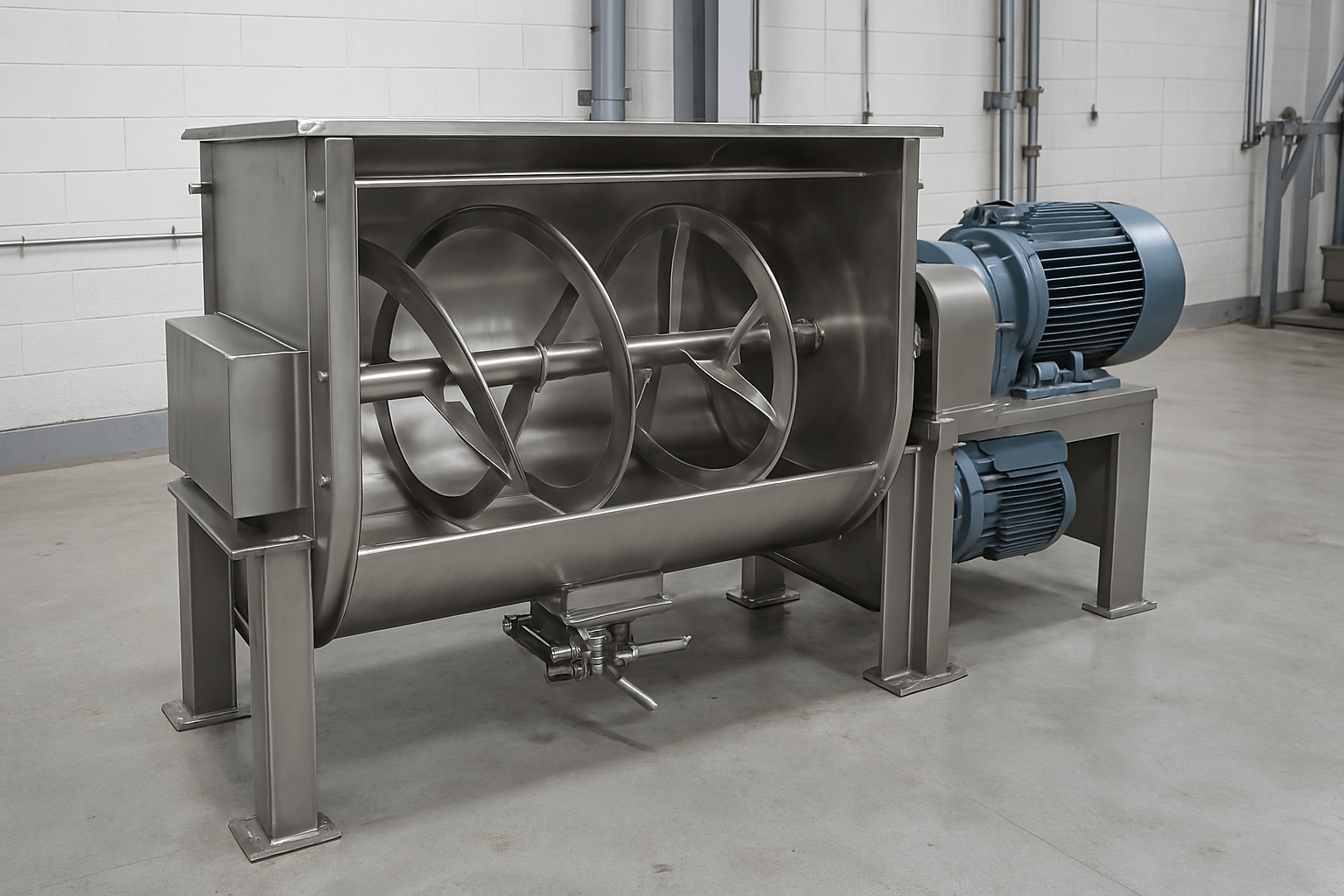Table of Contents
Introduction to Ribbon Blenders
Ribbon blenders are pivotal tools in industrial settings, renowned for blending different materials with exceptional uniformity. These machines are characterized by their helical blades, which achieve rapid mixing results through a combination of radial and lateral movements. The unique design ensures that the blades touch every particle of the mixture, a capability that underscores their efficiency compared to other types of mixers.
The evolution of ribbon blenders from simple, labor-intensive manual systems to advanced, automated machinery reflects the broader narrative of industrial innovation. Initially, ribbon blenders were used in limited applications but have since evolved to become integral components across diverse manufacturing sectors. This evolution demonstrates technological advancement and the increasing complexity and demands of modern industries, where precision and efficiency are paramount.
Industrial Applications of Ribbon Blenders
The versatility of ribbon blenders makes them indispensable tools across various industries. In the food industry, for instance, these blenders mix ingredients necessary for producing baked goods, sauces, and seasonings, ensuring a consistent taste and texture every time. A ribbon mixer is particularly effective for handling delicate ingredients, as its gentle yet thorough mixing action helps maintain product integrity without causing excessive shear. Reliability in the blending process eliminates the risk of uneven flavor distribution, which could lead to product rejection or consumer dissatisfaction.
In the pharmaceutical industry, ribbon blenders’ precision is invaluable for ensuring that each batch of medication is consistent in its active ingredients. This precision helps adhere to stringent safety and efficacy standards required for pharmaceutical products. Similarly, the chemical industry benefits from ribbon blenders’ efficiency in creating uniform mixtures necessary for producing paints, coatings, and chemical compounds, where any irregularity in texture or composition can severely impact functionality and safety.
Key Features of Ribbon Blenders
The construction and design features of ribbon blenders significantly enhance their mixing capabilities. The centerpiece of these blenders is the intermeshing helical blades, which are strategically designed to produce a turbulent flow that thoroughly mixes materials regardless of their physical properties. This capability is crucial for industries that require homogeneous mixtures, such as the food and pharmaceutical sectors, where the quality and safety of the final product are non-negotiable.
Stainless steel, known for its corrosion resistance, is often used to construct ribbon blenders. This choice enhances durability and enables handling various materials, including potentially corrosive ones. Incorporating modern motors and drive systems ensures these blenders can operate efficiently under different load conditions.
Factors to Consider When Choosing a Ribbon Blender
Choosing the right ribbon blender involves several considerations to ensure it aligns with specific operational needs. Two of the primary factors are size and capacity, which should match the production scale. A too-small blender may lead to operational bottlenecks and compromise production timelines, while an excessively large blender could unnecessarily escalate energy costs without additional benefits.
Another critical consideration is material compatibility. The processed materials must be compatible with the blender’s construction to prevent contamination and equipment degradation. This is especially vital in pharmaceutical sectors, where contamination can have dire consequences. Additionally, the configuration of the mixer blades must suit the particular blending needs. A gentler blade configuration may be necessary for delicate handling materials, whereas more robust setups might be ideal for thicker, more robust materials.
Also Read: The Iconic Design Features of the Bel Air
Advantages of Using Ribbon Blenders
Ribbon blenders offer numerous advantages, not the least of which is their capacity for uniform mixing. This uniformity is essential in industries where product consistency is linked to quality and compliance standards. Furthermore, ribbon blenders’ cost-effectiveness makes them a prudent investment. Their robust design ensures longevity and reliable performance, translating to lower maintenance costs and less frequent replacement needs. Ribbon blenders’ versatility in handling diverse types of materials further adds to their appeal. From fine powders to more viscous pastes, these blenders manage various physical consistencies, making them suitable for various applications.
Future Trends in Industrial Mixing
The landscape of industrial mixing is constantly evolving, with future trends indicating a shift toward more sustainable and eco-friendly practices. Manufacturers are increasingly seeking ways to minimize the environmental impact of their operations without sacrificing performance. This trend is driving the design of ribbon blenders with features that promote sustainability, such as energy-efficient components and recyclable materials.
As industries grapple with efficiency and sustainability challenges, ribbon blenders are increasingly being configured to meet these dual objectives. By aligning with these trends, businesses contribute to environmental preservation and potentially gain a competitive advantage by appealing to a more environmentally conscious consumer base.


